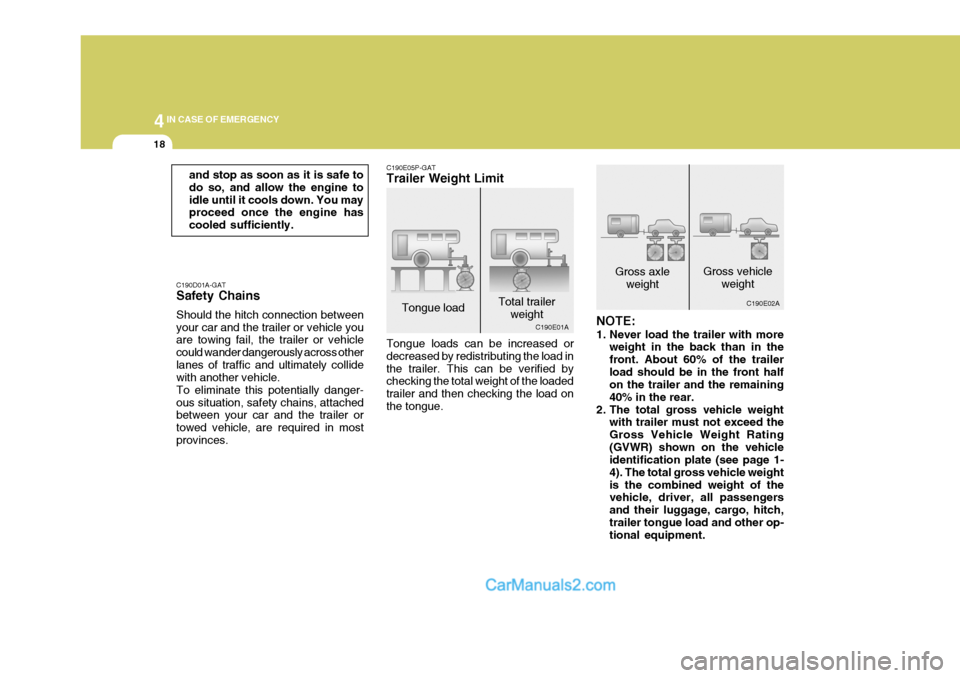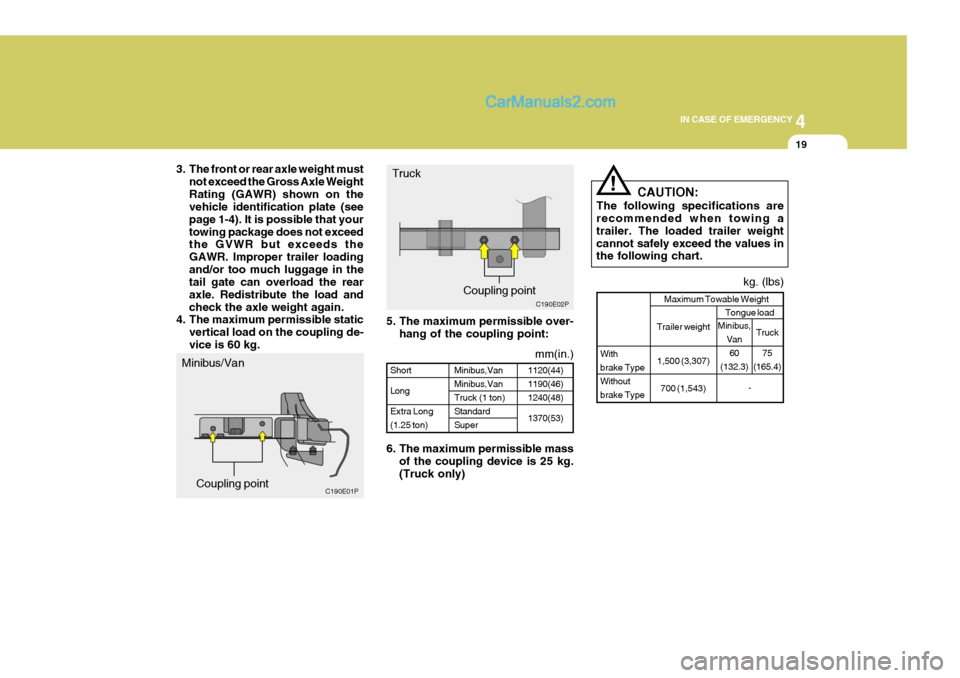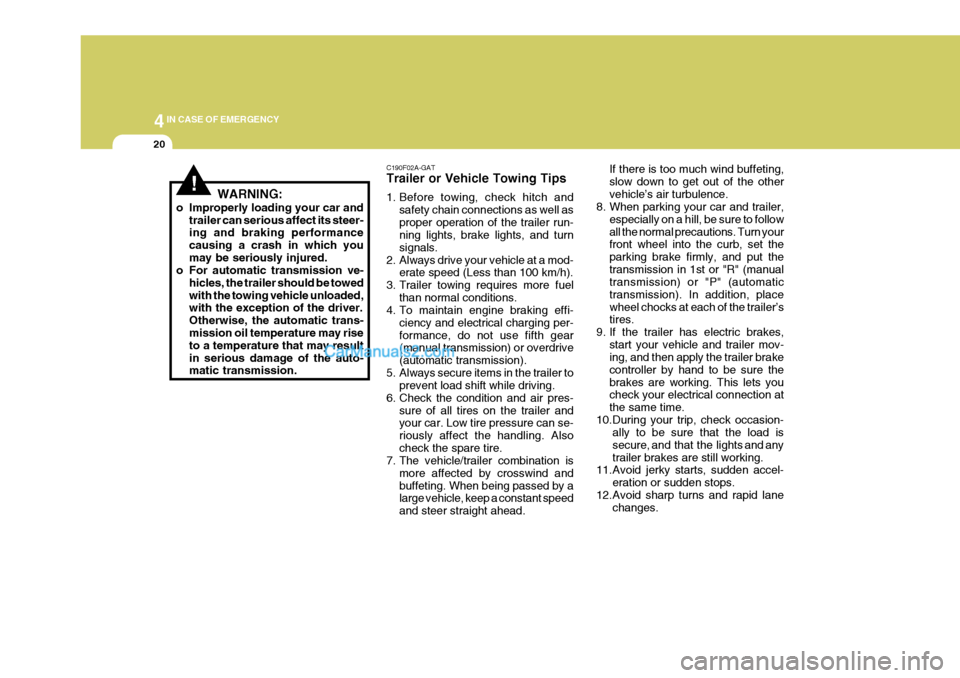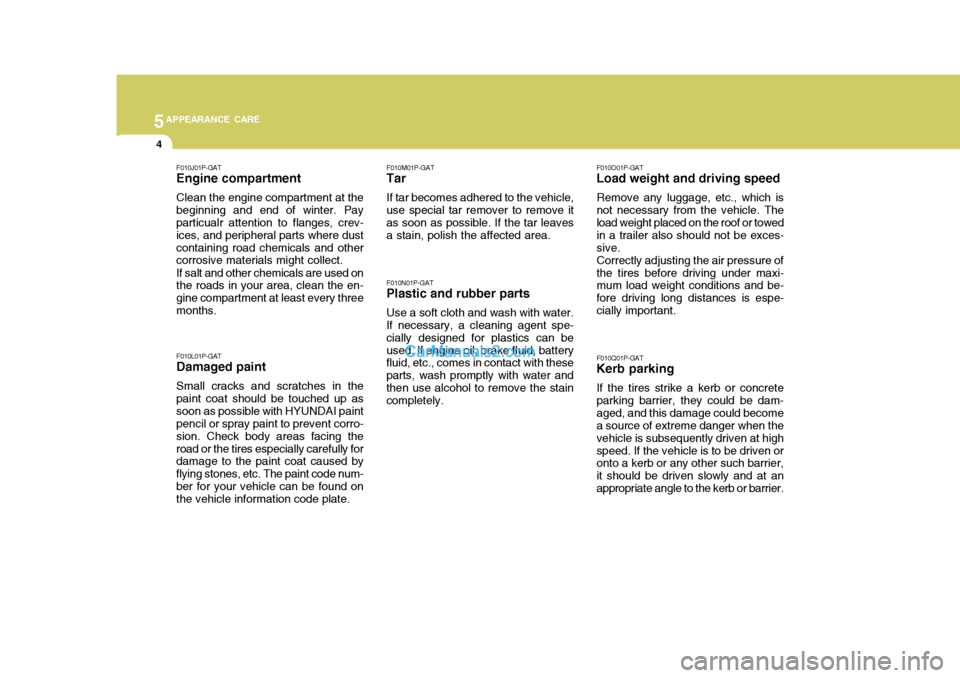2005 Hyundai H-1 (Grand Starex) tow
[x] Cancel search: towPage 119 of 205

44IN CASE OF EMERGENCY
18
and stop as soon as it is safe to do so, and allow the engine toidle until it cools down. You may proceed once the engine has cooled sufficiently.
C190D01A-GAT Safety Chains Should the hitch connection between your car and the trailer or vehicle you are towing fail, the trailer or vehicle could wander dangerously across otherlanes of traffic and ultimately collide with another vehicle. To eliminate this potentially danger-ous situation, safety chains, attached between your car and the trailer or towed vehicle, are required in mostprovinces. C190E05P-GAT Trailer Weight Limit Tongue loads can be increased or decreased by redistributing the load inthe trailer. This can be verified by checking the total weight of the loaded trailer and then checking the load onthe tongue.
NOTE:
1. Never load the trailer with more
weight in the back than in the front. About 60% of the trailerload should be in the front half on the trailer and the remaining 40% in the rear.
2. The total gross vehicle weight with trailer must not exceed theGross Vehicle Weight Rating(GVWR) shown on the vehicle identification plate (see page 1- 4). The total gross vehicle weightis the combined weight of the vehicle, driver, all passengers and their luggage, cargo, hitch,trailer tongue load and other op- tional equipment.
Tongue load
Total trailer
weight Gross axle
weight Gross vehicle
weight
C190E01A C190E02A
Page 120 of 205

4
CORROSION PREVENTION AND APPEARANCE CARE
19
4
IN CASE OF EMERGENCY
19
5. The maximum permissible over-
hang of the coupling point:
6. The maximum permissible mass of the coupling device is 25 kg. (Truck only) CAUTION:
The following specifications are recommended when towing a trailer. The loaded trailer weightcannot safely exceed the values in the following chart.
!
Truck
Coupling point
1120(44) 1190(46)1240(48) 1370(53)
ShortLongExtra Long (1.25 ton) Minibus,VanMinibus,VanTruck (1 ton)StandardSuper
kg. (lbs)
With brake TypeWithoutbrake Type Maximum Towable Weight
Trailer weight
1,500 (3,307) 700 (1,543) Tongue load
-
Minibus,
Van60
(132.3) Truck
75
(165.4)
C190E02P
mm(in.)
C190E01P
3. The front or rear axle weight must
not exceed the Gross Axle Weight Rating (GAWR) shown on the vehicle identification plate (see page 1-4). It is possible that yourtowing package does not exceed the GVWR but exceeds the GAWR. Improper trailer loadingand/or too much luggage in the tail gate can overload the rear axle. Redistribute the load andcheck the axle weight again.
4. The maximum permissible static
vertical load on the coupling de-vice is 60 kg.
Minibus/Van
Coupling point
Page 121 of 205

44IN CASE OF EMERGENCY
20
!WARNING:
o Improperly loading your car and trailer can serious affect its steer- ing and braking performance causing a crash in which youmay be seriously injured.
o For automatic transmission ve-
hicles, the trailer should be towedwith the towing vehicle unloaded, with the exception of the driver. Otherwise, the automatic trans-mission oil temperature may rise to a temperature that may result in serious damage of the auto- matic transmission. C190F02A-GAT Trailer or Vehicle Towing Tips
1. Before towing, check hitch and
safety chain connections as well as proper operation of the trailer run- ning lights, brake lights, and turn signals.
2. Always drive your vehicle at a mod- erate speed (Less than 100 km/h).
3. Trailer towing requires more fuel than normal conditions.
4. To maintain engine braking effi-
ciency and electrical charging per-formance, do not use fifth gear (manual transmission) or overdrive (automatic transmission).
5. Always secure items in the trailer to prevent load shift while driving.
6. Check the condition and air pres- sure of all tires on the trailer and your car. Low tire pressure can se- riously affect the handling. Alsocheck the spare tire.
7. The vehicle/trailer combination is
more affected by crosswind andbuffeting. When being passed by a large vehicle, keep a constant speed and steer straight ahead. If there is too much wind buffeting,slow down to get out of the othervehicle’s air turbulence.
8. When parking your car and trailer,
especially on a hill, be sure to followall the normal precautions. Turn your front wheel into the curb, set the parking brake firmly, and put thetransmission in 1st or "R" (manual transmission) or "P" (automatic transmission). In addition, placewheel chocks at each of the trailer’s tires.
9. If the trailer has electric brakes, start your vehicle and trailer mov-ing, and then apply the trailer brake controller by hand to be sure thebrakes are working. This lets you check your electrical connection at the same time.
10.During your trip, check occasion- ally to be sure that the load issecure, and that the lights and anytrailer brakes are still working.
11.Avoid jerky starts, sudden accel-
eration or sudden stops.
12.Avoid sharp turns and rapid lane changes.
Page 122 of 205

4
CORROSION PREVENTION AND APPEARANCE CARE
21
4
IN CASE OF EMERGENCY
21BLEEDING THE FUEL SYSTEM
CAUTION:
If overheating should occur when towing, (temperature gauge reads near red zone), taking the followingaction may reduce or eliminate the problem.
1. Turn off the air conditioner.
2. Reduce highway speed.
3. Select a lower gear when going uphill.
4. While in stop and go traffic, place
the gear selection in park or neu-tral and idle the engine at a higher speed.
! E090A01P-GAT (Diesel Motor) The fuel system should be bled to remove air as described in the illustra- tion if the fuel supply is exhaustedduring travel, when the fuel filter is replaced, or if the vehicle is not used for a long time.
1. Loosen the air plug at the top of the
fuel filter. E090A01P
13.Avoid holding the brake pedal down
too long or too frequently. This could cause the brakes to overheat, re- sulting in reduced braking efficiency.
14.When going down a hill, shift into a
lower gear and use the engine brak-ing effect. When ascending a long grade, downshift the transmissionto a lower gear and reduce speed to reduce chances of engine over- loading and/or overheating.
15.If you have to stop while going uphill, do not hold the vehicle inplace by pressing on the accelera-tor. This can cause the automatic transmission to overheat. Use the parking brake or footbrake.
NOTE: When towing, check transmission fluid more frequently.
Page 129 of 205

44IN CASE OF EMERGENCY
28
If you suspect a blown fuse, follow this procedure:
1. Turn off the ignition and all other
switches.
2. Open the fuse box and examine each fuse. Remove each fuse by pulling it toward you (a small "fusepuller" tool is contained in the fuse box to simplify this operation).
3. Be sure to check all other fuses even if you find one that appears tohave burned out.
HSR40224. Replace the blown fuse by pressing
a new fuse of the same rating into place. The fuse should be a snug fit. If it is not, have the fuse clip repaired or replaced by a Hyundai dealer. Ifyou do not have a spare fuse, you may be able to borrow a fuse of the same or lower rating from an acces-sory you can temporarily get along without (the radio or cigarette light- er, for example). Always rememberto replace the borrowed fuse.
G200B02A
Good
Burned out
!
CAUTION:
A burned-out fuse indicates that there is a problem in the electrical circuit. If you replace a fuse and it blows as soon as the accessory isturned on, the problem is serious and should be referred to a Hyun- dai dealer for diagnosis and repair.Never replace a fuse with anything except a fuse with the same or a lower amperage rating. A highercapacity fuse could cause damage and create a fire hazard. NOTE: See page 4-40 for the fuse panel descriptions.
Page 135 of 205

44IN CASE OF EMERGENCY
34
HSRFL283
G270C01A-GAT SIDE REPEATER (If installed)
1. Push the cover toward the front of
the vehicle and remove it. HSRFL292
3. Replace with a new bulb. HSRFL284
2. Disconnect the power cord. G270D01P-GAT INTERIOR LIGHT Map light 1. Remove the plastic cover with a flat-
head screwdriver. HSRFL300
HSRFL297
With sunroof
Without sunroof
Page 149 of 205

5
APPEARANCE CARE
3
F010G01P-GAT
Window glass
The window glass can normally be cleaned using only a sponge and wa- ter. Glass cleaner can be used to remove oil, grease, dead insects, etc. After washing the glass, wipe dry with aclean, dry, soft cloth.Never use the same cloth to wipe thewindow glass as would be used towipe the paintwork; wax from the painted surfaces could adhere to the glass and reduce its transparency andvisibility. F010H01P-GAT
Wiper blades
Use a soft cloth and glass cleaner to remove grease, dead insects, etc., from the wiper blades. Replace thewiper blades when they no longer wipe properly. F010I01P-GAT
Chassis and underbody protec- tion
Your vehicle’s underbody has been
treated at the factory in order to pro- tect it from rust and corrosion. Some areas have been injected with anti-corrosion agents and wax. The effectiveness of these measures,
however, will be reduced by flyingstones, road chemicals, etc., as the vehicle is driven.
Have the underbody checked regularly
(autumn and spring) and have addi- tional protection treatment carried outas required. As not all of the commer- cially available materials are suitable for use on your vehicle, it is recom-mended that you have this work done at an authorized HYUNDAI dealer.
When washing the vehicle, especially
in winter, spray the underbody withwater to remove dirt and dust which might contain salts, road chemicals,etc. F010K01P-GAT Upholstery and Interior To maintain the value of your new vehicle, handle the upholstery care- fully and keep the interior clean. Use a vacuum cleaner and brush to clean the seats. If stained, vinyl and synthetic leather should be cleanedwith an appropriate cleaner, and cloth fabrics can be cleaned with either up- holstery cleaner or a 3% solution ofneutral detergent in lukewarm water.Clean the carpeting with a vacuumcleaner and remove any stains withcarpet cleaner.Oil and grease can be removed bylightly dabbing with a clean colorfast cloth and benzene or spot remover.
Page 150 of 205

5APPEARANCE CARE
4
F010L01P-GAT Damaged paint Small cracks and scratches in the paint coat should be touched up assoon as possible with HYUNDAI paint pencil or spray paint to prevent corro- sion. Check body areas facing theroad or the tires especially carefully for damage to the paint coat caused by flying stones, etc. The paint code num-ber for your vehicle can be found on the vehicle information code plate. F010M01P-GAT
Tar
If tar becomes adhered to the vehicle, use special tar remover to remove it as soon as possible. If the tar leaves a stain, polish the affected area. F010N01P-GAT
Plastic and rubber parts
Use a soft cloth and wash with water.
If necessary, a cleaning agent spe- cially designed for plastics can beused. If engine oil, brake fluid, battery fluid, etc., comes in contact with these parts, wash promptly with water andthen use alcohol to remove the stain completely. F010O01P-GAT
Load weight and driving speed
Remove any luggage, etc., which is not necessary from the vehicle. The load weight placed on the roof or towed in a trailer also should not be exces-sive.Correctly adjusting the air pressure ofthe tires before driving under maxi- mum load weight conditions and be- fore driving long distances is espe-cially important. F010Q01P-GAT
Kerb parking
If the tires strike a kerb or concrete parking barrier, they could be dam-aged, and this damage could become a source of extreme danger when the vehicle is subsequently driven at highspeed. If the vehicle is to be driven or onto a kerb or any other such barrier, it should be driven slowly and at anappropriate angle to the kerb or barrier.
F010J01P-GAT Engine compartment Clean the engine compartment at the beginning and end of winter. Pay particualr attention to flanges, crev- ices, and peripheral parts where dustcontaining road chemicals and other corrosive materials might collect. If salt and other chemicals are used on the roads in your area, clean the en- gine compartment at least every threemonths.